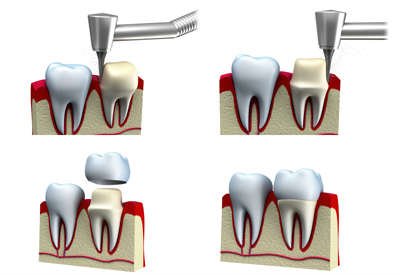CROWNS AND BRIDGES CAN RESHAPE YOUR SMILE
A dental crown is a tooth-shaped “cap” that fits snugly over a tooth, completely covering it. Usually a crown is required to restore the size, shape, strength, or appearance of a tooth. Crowns fix these issues by encasing the visible portion of the tooth that lies above the gum line.

A dental crown may be needed in the following situations:
• If you have a weak tooth (i.e. from decay), you may need a crown to prevent the tooth from breaking or to hold together parts of a cracked tooth.
• If you have a tooth that is already broken or that has been severely worn down, you may need a crown.
• Crowns can also be used to cover and support a tooth with a large filling when there is not much tooth left.
• Crowns can be used to hold a dental bridge in place.
• Crowns can be placed over misshapen or discolored teeth.
• If you have had a dental implant placed, a crown may be used to restore the original function of the lost tooth.
• Or, you may need a crown to cover a tooth that has had a root canal.
THE PROCEDURE
Preparing a tooth for a crown usually takes two office visits. The first visit will be to prepare the tooth for the crown. During this first appointment, the doctor will take x-rays to ensure that the root of the tooth and surrounding bone are healthy enough to support a dental crown. If the teeth have significant decay, then a root canal may be required before a crown can be placed.
Before the procedure begins, the doctor will numb your tooth and surrounding gum tissue. The tooth receiving the crown will be prepared along the chewing surface and sides to make room for the crown material. After the tooth has been reshaped, an impression of the tooth will be made. This impression will be used to create your unique crown. Manufacturing of the crown usually takes three weeks.
During your second visit, we will check the health of your tissue. Healthy gums ensure most effective cementation of the crown.
At your last visit, the crown will be adjusted and cemented in place.
BRIDGE
A bridge is designed to literally “bridge” the gap between one or more missing teeth. A bridge is a false tooth cemented to the teeth adjacent to the space.
Bridges are designed to restore the aesthetics of your smile and the functionality of the mouth, allowing you to eat and speak properly. Bridges help maintain the shape of your face so that cheeks do not sink where teeth are missing. Bridges can help distribute bite forces by replacing missing teeth, and they can prevent teeth from drifting out of position.
THE PROCEDURE
Like crowns, placing a bridge requires three office visits. During the first visit, the teeth that serve as abutments (the teeth on either side of the missing tooth) are prepared for their crown. The enamel on each tooth is removed to allow room for the crown material. After the tooth has been reshaped, an impression of the area will be made. These impressions are used to fabricate a custom bridge. Your doctor may make a temporary bridge for you to wear in order to protect the exposed teeth and gums while your bridge is being made. Manufacturing the bridge usually takes 3 weeks.
During your second visit, we will check the health of your tissue. Healthy gums ensure most effective cementation of the bridge.
At your last visit, the bridge will be adjusted and cemented in place.
